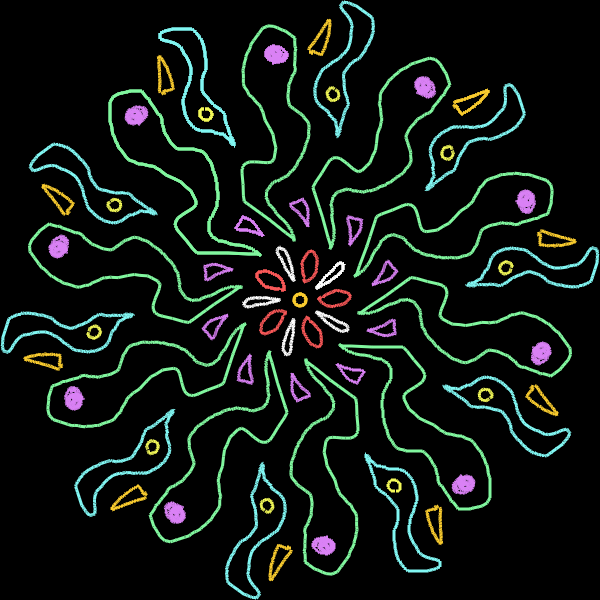andala
About
andala is a drawing web application which allows users to create beautiful, symmetrical designs. The app is powered through vanilla JavaScript DOM manipulation of an HTML canvas element.
Access the live site here.
How to use andala
- Choose your initial drawing preferences at the left of the page
- Begin drawing by clicking into the canvas
- Change your drawing preferences at any time and continue drawing
- Clear your canvas with the button at the right
Technical Implementation
The two most complicated components of the application are:
- Its canvas auto-calibration relative to user screen size & scroll
- Its real-time symmetry calculation via conversion of the canvas grid into a Cartesian coordinate plane
Canvas auto-calibration
Since an HTML canvas does not provide mouse coordinates when a user clicks over it, I dynamically calculated canvas coordinates from full window MouseEvent coordinates via the getCanvasCoords function. This translates the window's mouse coordinates into canvas coordinates which are agnostic to screen size and window scroll. The result is a precise drawing experience for the user even if s/he scrolls or changes screen size during a drawing session.
// from canvas.js
getCanvasCoords(){
const canvasPosition = this.canvasElement.getBoundingClientRect();
const canvasLeft = canvasPosition.left + window.scrollX;
const canvasTop = canvasPosition.top + window.scrollY;
return [canvasLeft, canvasTop];
}
Cartesian canvas symmetric calculations
Since an HTML canvas begins its coordinate system with (0,0) at the top left corner, I translated the canvas grid into a Cartesian plane. When a user clicks anywhere on the canvas, the distance from the origin is calculated as well as a set of symmetric point(s) which will be simultaneously drawn.
In the case of radial symmetry, the first user click calculates an initial angle theta about the origin. This, in conjunction with the radialOrder -- or number of symmetry slices -- is used to determine equidistantly-spaced points in radians whose canvas coordinates are calculated using trigonometry.
// from canvas.js
computeRadialSymPairs(e){
const symmetricPairSet = [];
const xDistance = (e.pageX - this.canvasLeftSide() - this.axisPoint[0]);
const yDistance = -(e.pageY - this.canvasTop() - this.axisPoint[1]);
const pythagoreanSum = Math.pow(xDistance, 2) + Math.pow(yDistance, 2);
const radius = Math.sqrt(pythagoreanSum);
let theta;
if (xDistance > 0 && yDistance >= 0){
// first quadrant
theta = Math.atan(yDistance / xDistance);
} else if (xDistance <= 0 && yDistance >= 0){
// second quadrant
theta = Math.PI - Math.asin(yDistance / radius);
} else if (xDistance < 0 && yDistance <= 0){
// third quadrant
theta = Math.PI + Math.atan(yDistance / xDistance);
} else if (xDistance >= 0 && yDistance <= 0){
// fourth quadrant
theta = (2 * Math.PI) - Math.acos(xDistance / radius);
}
const sliceSizeRadians = (2 * Math.PI) / this.radialOrder;
const thetaPrimes = [];
//note: thetaPrimes will not include theta since firstPair coordinates are already known from the user's click
for (let i = 1; i <= this.radialOrder; i ++){
thetaPrimes.push(theta + (sliceSizeRadians * i));
}
thetaPrimes.forEach(angle => {
const canvasX = (radius * Math.cos(angle)) + this.axisPoint[0];
const canvasY = this.axisPoint[1] - (radius * Math.sin(angle));
symmetricPairSet.push([canvasX, canvasY]);
});
return { symmetricPairSet };
}
Future Features
In the future, I plan to add the following features:
- User may customize canvas size
- User may undo a previous action
- User may draw with circles and other shapes in addition to line drawing
